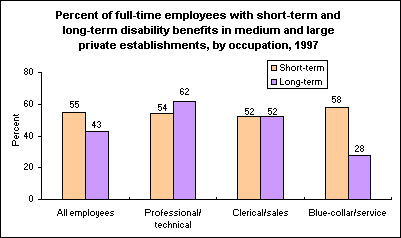November 29, 1999 (The Editor’s Desk is updated each business day.)
Blue-collar workers have highest eligibility for short-term disability benefits, lowest for long-term
Blue-collar employees in medium and large
private establishments are more likely to be eligible to receive
short-term disability benefits than other employees, but are much less
likely to receive long-term disability benefits.

[Chart data—TXT]
In 1997, 58 percent of full-time blue-collar workers in medium and
large private establishments were covered by a short-term disability
benefit. Coverage rates were somewhat lower for other workers: 54 percent
of professional and technical employees and 52 percent of clerical and
sales employees were covered by a short-term disability benefit.
While over half of blue-collar workers were eligible to receive
short-term disability benefits, just over a quarter—28 percent— could
receive long-term disability benefits. In contrast, 62 percent of
professional and technical employees were eligible for long-term
disability benefits, as were 52 percent of clerical and sales employees.
Short-term disability benefits provide for salary replacement, most
often partial, for a 6- to 12-month period. Long-term disability benefits
provide a monthly cash amount to eligible employees who, due to nonwork-related
illness or injury, are unable to work for an extended period of time; most
participants have a waiting period of 3 or 6 months, or until sick leave
and short-term disability benefits end, before benefit payments begin.
These data are from the BLS Employee Benefits
Survey. Learn more in Employee Benefits in Medium and Large
Establishments, 1997, BLS Bulletin 2517 (PDF
804 K)..
Of interest
Follow BLS on Twitter
Get links to the latest BLS news releases on the BLS Twitter feed.
|
